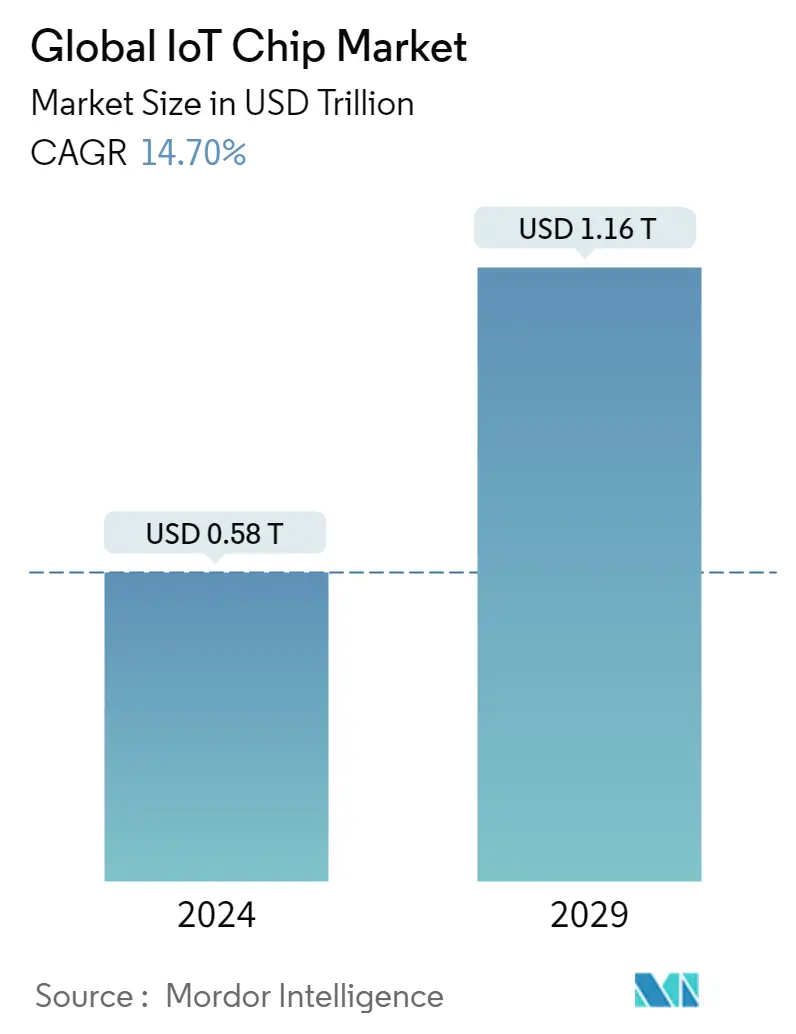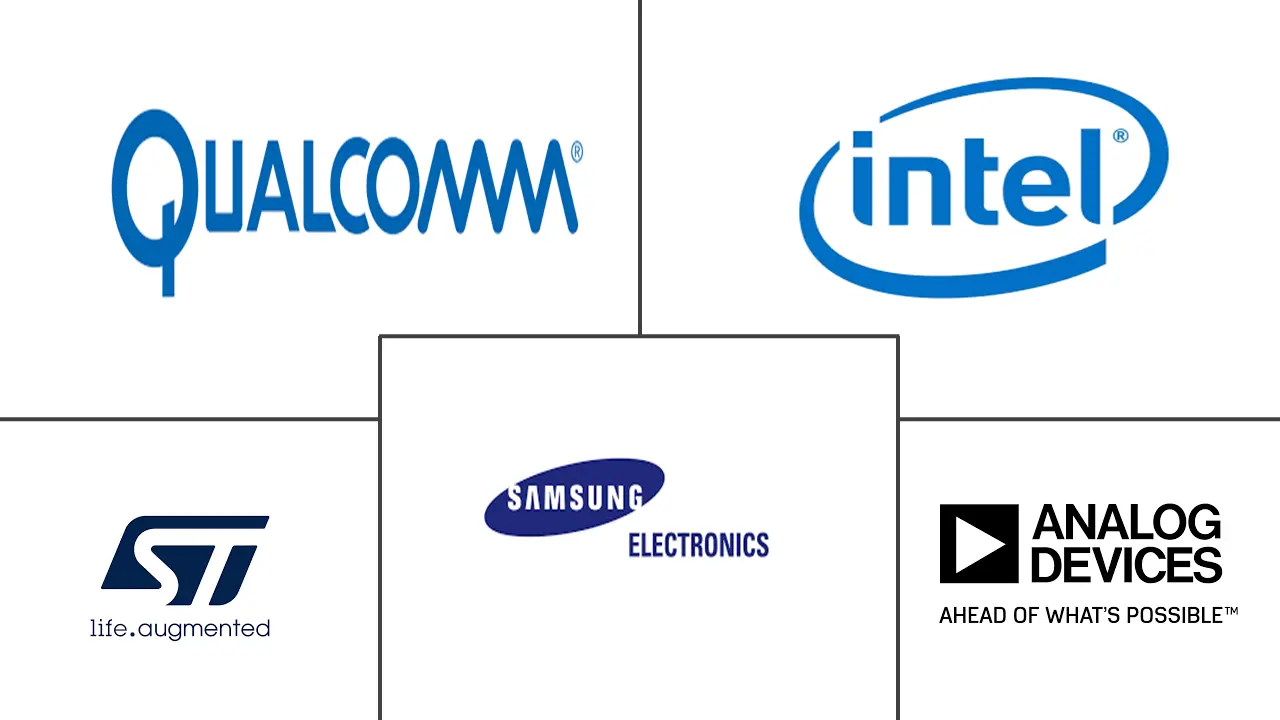Market Size of Global IoT Chip Industry

| Study Period | 2019 - 2029 |
| Market Size (2024) | USD 0.58 Trillion |
| Market Size (2029) | USD 1.16 Trillion |
| CAGR (2024 - 2029) | 14.70 % |
| Fastest Growing Market | Asia Pacific |
| Largest Market | North America |
Major Players
*Disclaimer: Major Players sorted in no particular order |
IoT Chip Market Analysis
The Global IoT Chip Market size is estimated at USD 0.58 trillion in 2024, and is expected to reach USD 1.16 trillion by 2029, growing at a CAGR of 14.70% during the forecast period (2024-2029).
Due to demand-side and supply-side factors, the growth in the number of IoT connections slowed down in specific sectors during the pandemic. Some IoT contracts were canceled or postponed due to firms going out of business or scaling back their spending. The rising demand for automation and the growing application of IoT devices across various end-user verticals, such as healthcare, consumer electronics, industrial, automotive, BFSI, and retail, are further driving the adoption of IoT devices.
- The growth is primarily attributed to the integration of connectivity competence in a wide range of devices and applications, coupled with the development of different networking protocols that have appreciably driven the growth of the IoT chip market across multiple end-user industries.
- In March 2022, two Indian researchers working at the Massachusetts Institute of Technology (MIT) built a low-power security chip designed to prevent side-channel attacks (SCA) against Internet of Things (IoT) devices. SCA uses vulnerabilities to allow information gleaned from the indirect effects of the behavior of system hardware rather than directly attacking programs and software.
- With the rapid increase in the number of IoT devices, the chip requirement for building these IoT devices is also expected to rise over the forecast period. Along with this, reducing energy consumption combined with the miniaturization of chips will be the priority of manufacturers.
- The increased deployment of 5G provides quick and efficient connectivity for Internet-of-Things (IoT) devices. Investments in the deployment of 5G technology are expected to drive market growth during the forecast period and beyond. The integration of 5G technology is seen as the next generation of mobile internet connectivity and is expected to offer faster and more reliable connections than current technologies. Thus, the booming IoT space and the supporting chip makers are expected to increase demand for IoT chips during the forecast period.
- Rising security concerns, such as software vulnerabilities and cyberattacks, may discourage many customers from using IoT devices. Such security concerns in the Internet of Things are particularly essential to organizations in healthcare, finance, manufacturing, logistics, retail, and other industries that have already started adopting IoT systems.
- With the COVID-19 outbreak worldwide, the market was significantly affected as severe supply chain shortages occurred across the globe. Moreover, the restriction imposed by governments across the globe on the movement of people also impacted production. However, as the world recovers from the pandemic, the need for more automated and advanced processes has become a key aspect of success. As such, the market for more IoT-enabled devices is anticipated to rise in the future, thereby creating strong demand for IoT chips across the globe.
IoT Chip Industry Segmentation
IoT modules or chips are technically identified as electronic devices embedded in machines, objects, and things, capable of connecting to wireless networks and sending and receiving data. These devices operate on different protocols, such as NB-IoT, LTE, and BLE 5.0.
The chip modules' revenue component is considered. The impact of COVID-19 has also been taken into consideration while arriving at the market projection.
The study comprises applications of these devices in end-user industries, such as healthcare, consumer electronics, industrial, automotive, BFSI, retail, building automation, and other end users across North America, Europe, Asia-Pacific, Latin America, and the Middle East & Africa.
| By Product | |
| Processor | |
| Sensor | |
| Connectivity IC | |
| Memory Device | |
| Logic Device | |
| Other Products |
| By End-user | |
| Healthcare | |
| Consumer Electronics | |
| Industrial | |
| Automotive | |
| BFSI | |
| Retail | |
| Building Automation | |
| Other End-users |
| By Geography | |
| North America | |
| Europe | |
| Asia Pacific | |
| Latin America | |
| Middle East & Africa |
Global IoT Chip Market Size Summary
The Global IoT Chip Market is poised for significant growth, driven by the increasing integration of connectivity capabilities across a diverse array of devices and applications. This expansion is further fueled by the development of various networking protocols, which have substantially contributed to the market's advancement across multiple end-user industries. The demand for IoT devices is being propelled by their growing application in sectors such as healthcare, consumer electronics, industrial, automotive, BFSI, and retail. The rapid proliferation of IoT devices necessitates a corresponding rise in chip requirements, with manufacturers prioritizing energy efficiency and miniaturization. The deployment of 5G technology is also a key factor, offering faster and more reliable connectivity, which is expected to bolster market growth. Despite challenges such as security concerns and the impact of the COVID-19 pandemic on supply chains, the market is recovering and is anticipated to see robust demand for IoT chips as automation and advanced processes become increasingly essential.
The IoT chip market is characterized by moderate competition, with numerous regional players engaging in strategic collaborations and acquisitions to enhance their market presence and profitability. Notable companies like Qualcomm, Samsung, and Intel are actively expanding their IoT chipset portfolios to cater to various applications, including logistics, smart cities, and consumer electronics. The Asia-Pacific region, particularly countries like South Korea and Singapore, is a significant contributor to IoT spending, supported by government initiatives and partnerships aimed at fostering semiconductor manufacturing and smart city projects. The industrial IoT trend is further supported by smart factory initiatives, which drive the adoption of manufacturing intelligence through extensive machine and sensor data utilization. As the market continues to evolve, the integration of IoT chips in sectors such as manufacturing, healthcare, and finance is expected to accelerate, leveraging advancements in connectivity and automation technologies.
Global IoT Chip Market Size - Table of Contents
-
1. MARKET INSIGHTS
-
1.1 Market Overview
-
1.2 Industry Attractiveness - Porter's Five Forces Analysis
-
1.2.1 Bargaining Power of Suppliers
-
1.2.2 Bargaining Power of Buyers
-
1.2.3 Threat of New Entrants
-
1.2.4 Threat of Substitute Products
-
1.2.5 Intensity of Competitive Rivalry
-
-
1.3 Technology Snapshot
-
1.4 Assessment of COVID-19 Impact on the Industry
-
-
2. MARKET SEGMENTATION
-
2.1 By Product
-
2.1.1 Processor
-
2.1.2 Sensor
-
2.1.3 Connectivity IC
-
2.1.4 Memory Device
-
2.1.5 Logic Device
-
2.1.6 Other Products
-
-
2.2 By End-user
-
2.2.1 Healthcare
-
2.2.2 Consumer Electronics
-
2.2.3 Industrial
-
2.2.4 Automotive
-
2.2.5 BFSI
-
2.2.6 Retail
-
2.2.7 Building Automation
-
2.2.8 Other End-users
-
-
2.3 By Geography
-
2.3.1 North America
-
2.3.2 Europe
-
2.3.3 Asia Pacific
-
2.3.4 Latin America
-
2.3.5 Middle East & Africa
-
-
Global IoT Chip Market Size FAQs
How big is the Global IoT Chip Market?
The Global IoT Chip Market size is expected to reach USD 0.58 trillion in 2024 and grow at a CAGR of 14.70% to reach USD 1.16 trillion by 2029.
What is the current Global IoT Chip Market size?
In 2024, the Global IoT Chip Market size is expected to reach USD 0.58 trillion.

